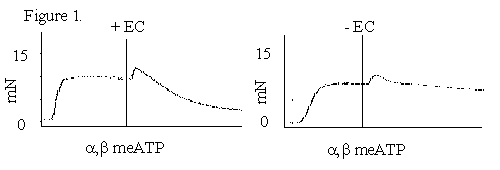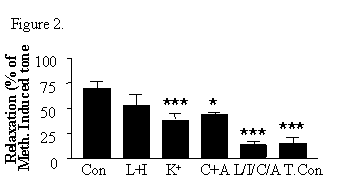| pA2 online © Copyright 2004 The British Pharmacological Society |
026P
GKT, University of London Winter Meeting December 2003 |
|
Endothelium
dependant relaxation induced by |
|
ATP is an important
inflammatory and vasoactive mediator, which acts via two receptor classes;
P2X and P2Y. Activation of P2X receptors has traditionally been associated
with the well characterised vasoconstrictor properties of ATP. However,
we have recently demonstrated that the ATP - induced vasodilator response
in rat mesenteric vessels appears to be linked to the constrictor properties
of ATP (Ravelic, 2002; Harrington and Mitchell, 2003). Secondly we have
identified endothelium derived hyperpolarising factor (EDHF) as the main
mediator in ATP-induced dilator responses in mesenteric vessels (Harrington
and Mitchell 2003). In the current study, we have investigated the effects
of the highly specific P2X receptor ligand, ![]() ,
ß methylene ATP on vasomotor responses of rat isolated mesenteric
arteries.
,
ß methylene ATP on vasomotor responses of rat isolated mesenteric
arteries.
Male Wistar rats (200 ± 15.4g) were killed by lethal exposure to CO2 followed by cervical dislocation. Second order mesenteric arteries were mounted in myographs and vasomotor responses recorded. Tissues were immersed in physiological salt solution (PSS), equilibrated (30 min) and tensions normalised as described previously (Mulvany and Halpern, 1977). Tissues were pre-contracted with methoxamine (10-5M). In some experiments the endothelium was removed mechanically.
10-4M
![]() , ß methylene
ATP (
, ß methylene
ATP (![]() , ß meATP)
induced a contraction followed by a vasodilation. In endothelial denuded
vessels the constrictor effects of
, ß meATP)
induced a contraction followed by a vasodilation. In endothelial denuded
vessels the constrictor effects of ![]() ,
ß methylene ATP were unaffected whilst the dilator responses were
abolished, n=3 (figure 1). The vasodilator actions of
,
ß methylene ATP were unaffected whilst the dilator responses were
abolished, n=3 (figure 1). The vasodilator actions of ![]() ,
ß methylene ATP (10-4M) were not
inhibited by the combination of 100mN L-NAME plus10µM indomethacin
(L/I; figure 2).
,
ß methylene ATP (10-4M) were not
inhibited by the combination of 100mN L-NAME plus10µM indomethacin
(L/I; figure 2).

Traces of arteries with (+) or without (-) endothelial cells (EC). However, dilator responses were inhibited by high K+ or the combination of 100nM charybdotoxin plus 500nM apamin (C/A) and abolished by the combination of L-NAME, indomethacin, charybdotoxin, and apamin, figure 2; (T. Con. represents time control).

Data is shown as the mean ± s.e.m. for n=3-8 experiments. Statistical significance was established using one-way ANOVA followed by Dunnetts Multiple Comparison Test. p<0.001; *p<0.05, ***p<0.001.
These results show that P2X receptor activation results in endothelial cell dependent vasodilation mediated primarily via the release of EDHF. These observations have important implications for our understanding of the role of purines in biological responses.
Harrington LS and
Mitchell JA (2003) Br. J. Pharm. 140, 8P.
Ralevic V (2002) Br. J. Pharm. 135: 1988-1994.
Mulvany MJ and Halpern W (1977) Circ Res 41:19-26.
This work was supported by the British Heart Foundation.